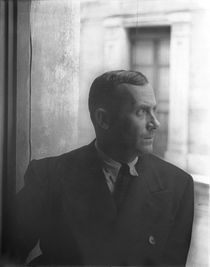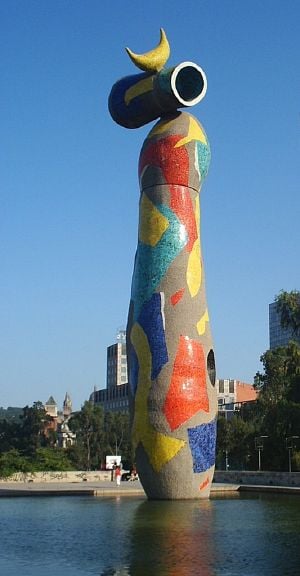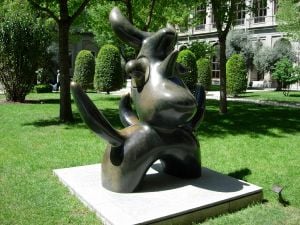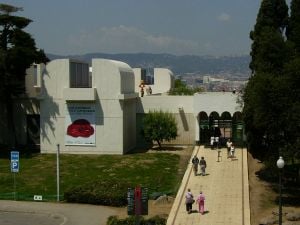Joan Miro
| Joan Miró | |
 Joan Miró, photo by Carl Van Vechten, June 1935 | |
| Birth name | Joan Miró i Ferrà |
| Born | April 20, 1893 Barcelona, Spain |
| Died | December 25, 1983 (aged 90) Palma de Mallorca, Spain |
| Nationality | Spanish |
| Field | Painting, Sculpture, Mural, and Ceramics |
| Training | Escuela de Bellas Artes de la Llotja, and Escuela de Arte de Francesco Galí, Circulo Artístico de Sant Lluc, 1907-1913 |
| Movement | Surrealism, Dada, Personal, Experimental |
| Influenced by | André Masson, Pablo Picasso, Tristan Tzara, and André Breton |
| Influenced | Arshile Gorky |
| Awards | 1954 Venice Biennale Grand Prize for Graphic Work, 1958 Guggenheim International Award, 1980 Gold Medal of Fine Arts, Spain |
Joan Miró i Ferrà (April 20, 1893 – December 25, 1983) was a Spanish Catalan painter, sculptor and ceramist born in Barcelona.
Earning international acclaim, his work has been interpreted as Surrealism, a sandbox for the subconscious mind, a re-creation of the childlike, and a manifestation of Catalan pride. Surrealism is a cultural movement that began in the mid-1920s, and is best known for the visual artworks and writings of the group members. From the Dada activities of World War I Surrealism was formed with the most important center of the movement in Paris and from the 1920s spreading around the globe.
The works feature the element of surprise, unexpected juxtapositions and the use of non sequiturs. Many Surrealist artists and writers regard their work as an expression of the philosophical movement first and foremost with the works serving merely as an artefact.
In numerous interviews dating from the 1930s onwards, Miró expressed contempt for conventional painting methods as a way of supporting bourgeoise society, and famously declared an "assassination of painting" in favor of upsetting the visual elements of established painting.
Biography
Born to the families of a goldsmith and watchmaker, the young Miró was drawn towards the arts community that was gathering in Montparnasse and in 1920 moved to Paris, France. There, under the influence of the poets and writers, he developed his unique style: organic forms and flattened picture planes drawn with a sharp line. Generally thought of as a Surrealist because of his interest in automatism and the use of sexual symbols (for example, ovoids with wavy lines emanating from them), Miró’s style was influenced in varying degrees by Surrealism and Dada,[1] yet he rejected membership to any artistic movement in the interwar European years. André Breton, the founder of Surrealism, described him as "the most Surrealist of us all." Miró confessed to creating one of his most famous works, Harlequin's Carnival, under similar circumstances:
- "How did I think up my drawings and my ideas for painting? Well I'd come home to my Paris studio in Rue Blomet at night, I'd go to bed, and sometimes I hadn't any supper. I saw things, and I jotted them down in a notebook. I saw shapes on the ceiling..."[2]
Career
In 1926, he collaborated with Max Ernst on designs for Sergei Diaghilev and the Ballet Russes. With Miró's help, Ernst pioneered the technique of grattage, in which he troweled pigment onto his canvases. Miró married Pilar Juncosa in Palma de Mallorca on October 12, 1929; their daughter Dolores was born July 17, 1931. Shuzo Takiguchi published the first monograph on Miró in 1940. In 1948-1949, although living in Barcelona, Miró made frequent visits to Paris to work on printing techniques at the Mourlot Studios (lithographs) and at the Atelier Lacourière (engravings). A close relationship lasting forty years developed with the printer Fernand Mourlot, resulting in the production of over 1,000 different lithographic editions.
In 1959, André Breton asked Miró to represent Spain in The Homage to Surrealism exhibition together with works by Enrique Tábara, Salvador Dalí, and Eugenio Granell. Miró created a series of sculptures and ceramics for the garden of the Maeght Foundation[3] in Saint-Paul-en-Forêt, France, which was completed in 1964.
Experimental style
Automatic drawing
Miró was among the first artists to develop automatic drawing as a way to undo previous established techniques in painting, and thus, with André Masson, represented the beginning of Surrealism as an art movement. Automatic drawing was developed as a means of expressing the subconscious or, more specifically the Freudian unconscious. In automatic drawing, the hand is allowed to move 'randomly' across the paper. In applying chance and accident to mark-making, drawing is to a large extent freed of rational control. Hence the drawing produced may be attributed in part to the subconscious and may reveal something of the psyche, which would otherwise be repressed.
Automatic drawing was pioneered by André Masson and then by Miró and Surrealists like Salvador Dalí, Jean Arp and André Breton. The technique was transferred to painting (as seen in Miró's paintings which often started out as automatic drawings), and has been adapted to other media; there have even been automatic "drawings" in computer graphics. Pablo Picasso was also thought to have expressed a type of automatic drawing in his later work, and particularly in his etchings and lithographic suites of the 1960s.
Most of the surrealists' automatic drawings were illusionistic, or more precisely, they developed into such drawings when representational forms seemed to suggest themselves. The surrealist artists often found that their use of 'automatic drawing' was not entirely automatic, rather it involved some form of conscious intervention to make the image or painting visually acceptable or comprehensible, "...Masson admitted that his 'automatic' imagery involved a two-fold process of unconscious and conscious activity...."[4]
After Surrealism
Miró chose not to become an official member of the Surrealists in order to be free to experiment with other artistic styles without compromising his position within the group. He pursued his own interests in the art world, beginning with automatic drawing and surrealism but encompassing expressionism and Color Field painting.
Miró's oft-quoted interest in the assassination of painting is derived from a dislike of bourgeois art of any kind, used as a way to promote propaganda and cultural identity among the wealthy.[5] Specifically, Miró responded to Cubism in this way, which by the time of his quote had become an established art form in France. He is quoted as saying "I will break their guitar," referring to Picasso's paintings, with the intent to attack the popularity and appropriation of Picasso's art by politics.[6]
In an interview with biographer Walter Erben, Miró expressed his dislike for art critics, saying, they "are more concerned with being philosophers than anything else. They form a preconceived opinion, then they look at the work of art. Painting merely serves as a cloak in which to wrap their emaciated philosophical systems."
Four-dimensional painting is a theoretical type of painting Miró proposed in which painting would transcend its two-dimensionality and even the three-dimensionality of sculpture.
In his final decades Miró accelerated his work in different media, producing hundreds of ceramics, including the Wall of the Moon and Wall of the Sun at the UNESCO building in Paris. He also made temporary window paintings (on glass) for an exhibit. In the last years of his life Miró wrote his most radical and least known ideas, exploring the possibilities of gas sculpture and four-dimensional painting.
In 1974, Miró created a tapestry for the World Trade Center in New York City. He had initially refused to do a tapestry, then he learned the craft and produced several ones. His World Trade Center Tapestry was displayed for many years at 2 World Trade Center building. It was one of the most expensive works of art lost during the attack of the twin towers.[7]
In 1981, Miró's The Sun, the Moon and One Star—later renamed Miró's Chicago—was unveiled. This large, mixed media sculpture is situated outdoors in the downtown Loop area of Chicago, across the street from another large public sculpture, the Chicago Picasso. Miró had created a bronze model of The Sun, the Moon and One Star in 1967. The model now resides in the Milwaukee Art Museum.
Late mural
One of Miró’s most important works in the United States is his only glass mosaic mural, Personnage Oiseaux[8] (Bird Characters), 1972-1978. Miró created it specifically for Wichita State University’s Edwin A. Ulrich Museum of Art,[9] Kansas. The mural is one of Miró’s largest two-dimensional projects, undertaken when he was 79 and completed when he was 85 years of age.[10] Fabrication of the mural was actually completed in 1977, but Miró did not consider it finished until the installation was complete.[11]
The glass mosaic was the first for Miró. Although he wanted to do others, time was against him and he was not able. He was to come to the dedication of the mural in 1978, but he fell at his studio in Palma de Mallorca, Spain, and was unable to travel. His island home and studio in Mallorca served him from 1956 until his death in 1983.
The entire south wall of the Ulrich Museum is the foundation for the 28 ft by 52 ft (8.53 m x 15.85 m) mural, comprised of one million pieces of marble and Venetian glass mounted on specially treated wood, attached to the concrete wall on an aluminum grid. A gift of the artist, donor groups paid for the fabrication by Ateliers Loire[12] of Chartres, France, and for its installation. The Ulrich Museum also acquired the 5 ½ ft by 12 ft oil on canvas maquette for the mural, but it has since been sold to establish a fund to support the museum’s acquisitions and any repairs needed to the mural. The entire mural was originally assembled by one artisan at Ateliers Loire using Miró’s maquette as a guide.
Fabricated under Miró’s personal direction and completed in 1977, the 40 panels comprising the mural were shipped to WSU, and the mural was installed on the Ulrich Museum’s façade in 1978. Although it has received little recognition, the mural is a seminal work in the artist’s career–one of Miró’s largest two-dimensional works in North America and the only type of its kind by the artist.[10]
Late life and death
He died bedridden at his home in Palma, Mallorca on December 25, 1983.[13] He suffered from heart disease and had visited a clinic for respiratory problems two weeks before his death.[14]
Legacy
Today, Miró's paintings sell for between US$250,000 and US$26 million. In 2012, Painting-Poem ("le corps de ma brune puisque je l'aime comme ma chatte habillée en vert salade comme de la grêle c'est pareil") (1925) was sold at Christie's London for $26.6 million.[15] Later that year at Sotheby's in London, Peinture (Etoile Bleue) (1927) brought nearly 23.6 million pounds with fees, more than twice what it had sold for at a Paris auction in 2007 and a record price for the artist at auction.[16]
Many of his pieces are exhibited today in the National Gallery of Art in Washington and Fundació Joan Miró in Montjuïc, Barcelona; his body is buried nearby, at the Montjuïc cemetery.
Awards
Joan Miró i Ferrà won several awards in his lifetime. In 1954 he was given the Venice Biennale print making prize, in 1958 the Guggenheim International Award,[17] and in 1980 he received the Gold Medal of Fine Arts from King Juan Carlos of Spain.[18] Miró received a doctorate honoris causa in 1979 from the University of Barcelona.
In 1981, the Palma de Mallorca City Council established the Fundació Pilar i Joan Miró a Mallorca, housed in the four studios that Miró had donated for the purpose.[19]
Joan Miro Foundation
The Fundació Joan Miró, Centre d'Estudis d'Art Contemporani (Joan Miró Foundation) is a museum of modern art honoring Joan Miró and located on Montjuïc in Barcelona, Catalonia.
The building housing the museum is itself a notable example of modern design drawing from regional traditions. It was completed in 1975 by architect Josep Lluís Sert, who conceived it like an open space, with big terraces and interior courtyards that allowed a correct circulation of the visitors. The building was broadened in 1986 to add the library and the auditorium.
The Foundation has also a space named "Espai 13," dedicated especially to promote the work of young artists who experiment with the art. Also temporary exhibitions of works of other painters are carried out. Moreover, the foundation carries out itinerant exhibitions to introduce the work of the Spanish artist.
Notes
- ↑ Miró's art biography at guggenheimcollection.org.
- ↑ Janis Mink, Miró, (Los Angeles: Taschen, 2003 ISBN 9783822896099), 43.
- ↑ Maeght Foundation, Retrieved February 24, 2009.
- ↑ Jemma Montagu, The Surrealists: Revolutionaries in Art & Writing 1919-1935, (London: Tate Pub., 2002. ISBN 9781854373670), 15
- ↑ M. Rowell, Joan Mirό: Selected Writings and Interviews (London: Thames & Hudson, 1987), 114-116.
- ↑ Peter Schjeldahl, Angry Young Man - Joan Miro, Museum of Modern Art, The New Yorker, November 10, 2008. Retrieved September 23, 2015.
- ↑ Art Works Lost in WTC Attacks Valued at, Insurance Journal, October 8, 2001. Retrieved February 20, 2009.
- ↑ Personnage Oiseaux (Bird Characters), 1972-1978 Retrieved February 20, 2009.
- ↑ Ulrich Museum of Art Retrieved February 20, 2009.
- ↑ 10.0 10.1 Martin H. Bush, The Edwin A Ulrich Museum of Art, Wichita State University. Wichita, KS: The Edwin A Ulrich Museum of Art, Wichita State University, 1980.
- ↑ Miró’s mural as it appears installed on the façade of the Ulrich Museum, Wichita State University, Kansas. Retrieved February 20, 2009.
- ↑ Ateliers Loire, Chartres, France Retrieved February 20, 2009.
- ↑ Joan Miró (Spanish), 1893-1983: Featured artist works, exhibitions and biography from Walton Fine Arts Retrieved February 20, 2009.
- ↑ Joan Miró dies in Spain at 90 The New York Times, December 26, 1983. Retrieved September 23, 2015.
- ↑ Joan Miro (1893-1983) | Painting-Poem ("le corps de ma brune puisque je l'aime comme ma chatte habillée en vert salade comme de la grêle c'est pareil") Christies.com, February 7, 2012. Retrieved September 23, 2015
- ↑ BBC News - Joan Miro painting smashes auction record Bbc.co.uk, June 20, 2012. Retrieved September 23, 2015.
- ↑ Biography from the Guggenheim Museum lists some of his awards Retrieved February 20, 2009.
- ↑ Biography from ArtNet lists Miro's Gold Medal award from King Juan Carlos Retrieved February 20, 2009.
- ↑ The Pilar and Joan Miró Foundation in Mallorca, Spain Retrieved September 23, 2015.
ReferencesISBN links support NWE through referral fees
- Dupin, Jacques. Joan Miró: Life and Work. Abrams, 1962. OCLC 175171974
- Mink, Janis. Joan Miró. Los Angeles: Taschen, 2003. ISBN 9783822896099
- Montagu, Jemma. The Surrealists: Revolutionaries in Art & Writing 1919-1935. London: Tate Pub., 2002. ISBN 978-1854373670
- Rowell, Margit. Joan Miró: Selected Writings and Interviews. Boston: G.K. Hall, 1986. ISBN 978-0805799569
External links
All links retrieved August 1, 2022.
Credits
New World Encyclopedia writers and editors rewrote and completed the Wikipedia article in accordance with New World Encyclopedia standards. This article abides by terms of the Creative Commons CC-by-sa 3.0 License (CC-by-sa), which may be used and disseminated with proper attribution. Credit is due under the terms of this license that can reference both the New World Encyclopedia contributors and the selfless volunteer contributors of the Wikimedia Foundation. To cite this article click here for a list of acceptable citing formats.The history of earlier contributions by wikipedians is accessible to researchers here:
The history of this article since it was imported to New World Encyclopedia:
Note: Some restrictions may apply to use of individual images which are separately licensed.


